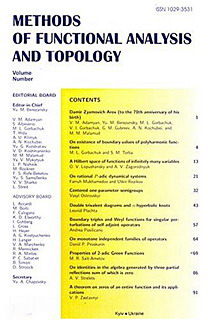Vol. 26 (2020), no. 1
Full indefinite Stieltjes moment problem and Padé approximants
Volodymyr Derkach, Ivan Kovalyov
MFAT 26 (2020), no. 1, 1-26
1-26
Full indefinite Stieltjes moment problem is studied via the step-by-step Schur algorithm. Naturally associated with indefinite Stieltjes moment problem are generalized Stieltjes continued fraction and a system of difference equations, which, in turn, lead to factorization of resolvent matrices of indefinite Stieltjes moment problem. A criterion for such a problem to be indeterminate in terms of continued fraction is found and a complete description of its solutions is given in the indeterminate case. Explicit formulas for diagonal and sub-diagonal Padé approximants for formal power series corresponding to indefinite Stieltjes moment problem and convergence results for Padé approximants are presented.
Entropy functionals and their extremal values for solving the Stieltjes matrix moment problem
MFAT 26 (2020), no. 1, 27-38
27-38
Entropy functionals and their extremal values for solving the Stieltjes matrix moment problem are defined and investigated for the first time. Explicit formulas for the extremal values of the entropy over the set of solutions of the Stieltjes matrix moment problem are obtained. A geometric interpretation in terms of Weyl matrix intervals is presented.
Selfadjoint extensions of relations whose domain and range are orthogonal
S. Hassi, J.-Ph. Labrousse, H.S.V. de Snoo
MFAT 26 (2020), no. 1, 39-62
39-62
The selfadjoint extensions of a closed linear relation $R$ from a Hilbert space $\mathfrak H_1$ to a Hilbert space $\mathfrak H_2$ are considered in the Hilbert space $\mathfrak H_1\oplus\mathfrak H_2$ that contains the graph of $R$. They will be described by $2 \times 2$ blocks of linear relations and by means of boundary triplets associated with a closed symmetric relation $S$ in $\mathfrak H_1 \oplus \mathfrak H_2$ that is induced by $R$. Such a relation is characterized by the orthogonality property ${\rm dom\,} S \perp {\rm ran\,} S$ and it is nonnegative. All nonnegative selfadjoint extensions $A$, in particular the Friedrichs and Krein-von Neumann extensions, are parametrized via an explicit block formula. In particular, it is shown that $A$ belongs to the class of extremal extensions of $S$ if and only if ${\rm dom\,} A \perp {\rm ran\,} A$. In addition, using asymptotic properties of an associated Weyl function, it is shown that there is a natural correspondence between semibounded selfadjoint extensions of $S$ and semibounded parameters describing them if and only if the operator part of $R$ is bounded.
Upper semi-Fredholm and Kato spectrum of an $\alpha$-times integrated semigroup
MFAT 26 (2020), no. 1, 63-67
63-67
Let $(T(t))_{t\geq 0}$ be an $\alpha$-times integrated semigroup with generator $A$ on a Banach space $X$. In this paper, we show that the spectral mapping theorem holds for upper semi-Fredholm spectrum and we will give some consequences of this result. We also give an application on the Schrödinger operator.
On the existence of a global diffeomorphism between Fréchet spaces
MFAT 26 (2020), no. 1, 68-75
68-75
We provide sufficient conditions for existence of a global diffeomorphism between tame Fréchet spaces. We prove a version of the mountain pass theorem which plays a key ingredient in the proof of the main theorem.
Eigenvalues of Schrödinger operators near thresholds: two term approximation
MFAT 26 (2020), no. 1, 76-87
76-87
We consider one dimensional Schrödinger operators \begin{equation*} H_\lambda=-\frac{d^2}{dx^2}+U+ \lambda V_\lambda \end{equation*} with nonlinear dependence on the parameter $\lambda$ and study the small $\lambda$ behavior of eigenvalues. Potentials $U$ and $V_\lambda$ are real-valued bounded functions of compact support. Under some assumptions on $U$ and $V_\lambda$, we prove the existence of a negative eigenvalue that is absorbed at the bottom of the continuous spectrum as $\lambda\to 0$. We also construct two-term asymptotic formulas for the threshold eigenvalues.
Automorphisms of Kronrod-Reeb graphs of Morse functions on 2-torus
Anna Kravchenko, Bohdan Feshchenko
MFAT 26 (2020), no. 1, 88-96
88-96
This paper is devoted to a study of special subgroups of automorphism groups of Kronrod-Reeb graphs of Morse functions on $2$-torus $T^2$ which arise from actions of diffeomorphisms preserving a given Morse function on $T^2$. In this paper we give a full description of such classes of groups.


